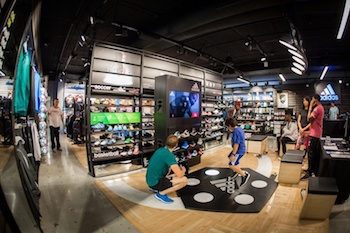Measuring Up: Defining Success For In-Store Digital

- What kind of engagement should we expect from our digital program, and how do we measure success? These are a fairly common set of questions when looking at in-store activations and making an investment in tech. The answer to this is highly dependent on the goals outlined at the onset of the project: What defines success for you?
- For some of our clients it’s a measured sales lift. That’s pretty cut and dried, and I don’t think there is a retailer out there that isn’t looking for that. However, success for others can look much different. We’ve seen targets set around an increase in the number of door swings. We’ve seen goals that are related to customer experience, such as decreasing the time to decision by leveraging tools to help educate/advise customers. There are even objectives that live in the world of operational efficiency, helping eliminate physical inventory or reduce logistic costs. Most all of these ultimately roll back up to a sales lift, but it’s important to understand that success will vary depending on the individual business objectives and there isn’t a one-size-fits-all answer here.
- Defining the program objectives is likely the hardest part for many. That portion can take some time to rationalize and build strategy around. The good news is that measuring to that objective isn’t necessarily difficult and there are a lot of great approaches to measure up.
- For measuring engagement, we employ several reporting options. Each of these provides rich metrics that help understand the engagement story.
- 1. Customer Surveys: This is a simple-yet-effective, time-tested method for determining engagement. Often this would require a survey prior to deployment of the activation or program to serve as a basis, and then another survey post deployment to compare against. Alternatively, test and control stores can be used to take concurrent measurement. This technique can be used across several stores in varying markets to ensure the data is reliable, and it has the added benefit of having a human operator who may uncover some additional insights just through observations.
- 2. Built-in Measurement: For technology-infused activations, it’s very common to build in reporting features to provide engagement data. This often includes data on every button push, interaction time, number of sessions, and just about any other point of data surrounding the activations use, what content is being engaged with, and how long it’s interacted with. This provides a ton of data to use, but generally needs to be paired with additional data sets to provide the full picture. For example, knowing overall store traffic would let you calculate percentage of customers engaging with the interactive. Incorporating sales data on a product would let you gain insight into how effective the activation is with upsells, or increasing volume of sale.
- 3. External Sensors: There are several reliable options for external data capture. For this type of tracking it’s common for cameras to be placed in the ceiling above the desired area of measurement. These cameras will track consumers’ movement to provide accurate engagement data including number of interactions, dwell time, hotspots, peak times, and much more. Some of these systems can even provide relatively accurate demographic information. This information can be very helpful in understanding how a digital program is performing, if the placement of it makes sense, and other factors that would apply toward the desired objectives.
- What constitutes success varies from customer to customer. This is a topic of conversation that must be determined up front to effectively measure against it. In retail, success is commonly measured in sales lift. However, this is not always the case. Some look to improved NPS scores, increase customer traffic, or increase the length of stay as their points of measurement for success.
- So what defines success? For us, it’s if our customers achieve the objectives they set out to hit. Sometimes this means modifying programs as new data comes in. Sometimes it means trying a few programs to test which is best against target. Start with your desired outcome and reverse engineer the program details from there.
- This blog was originally published on Bluewater’s website: http://thoughts.bluewatertech.com/measuring-up-defining-success-for-in-store-digital
Get the AVTechnology Newsletter
A daily selection of features, industry news, and analysis for AV/IT professionals. Sign up below.
TOPICS
MORE FROM AVNETWORK...
